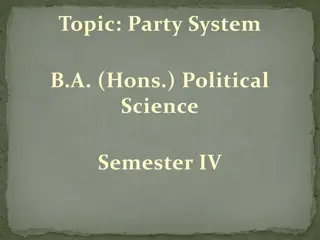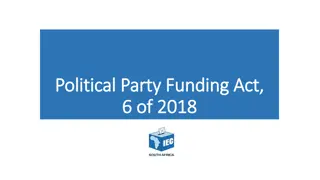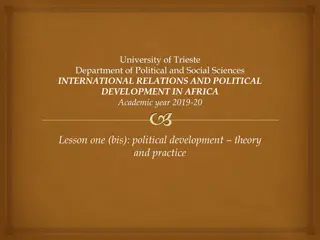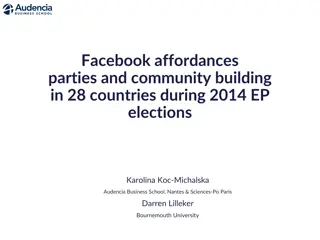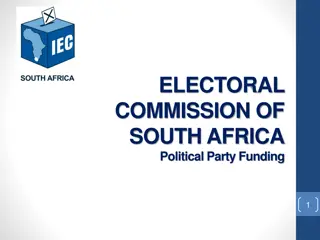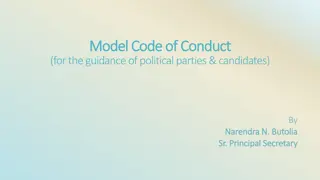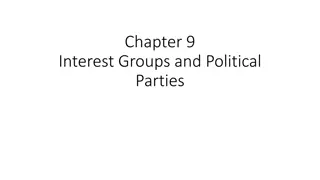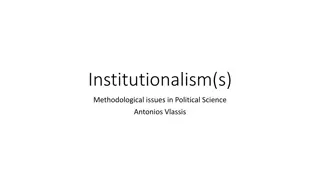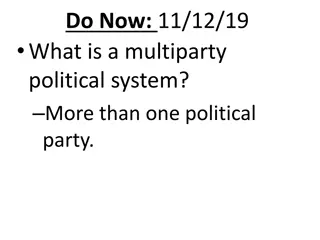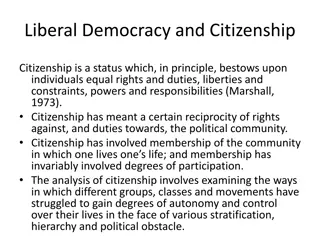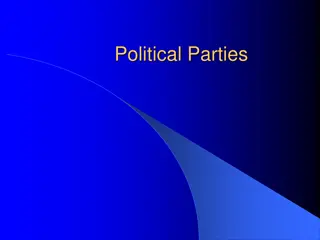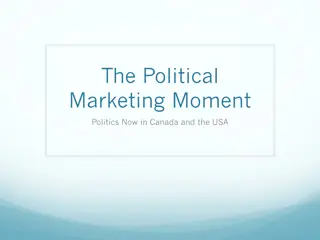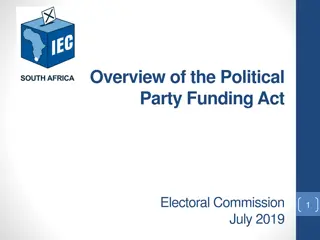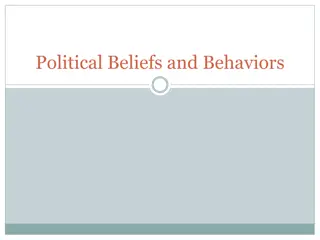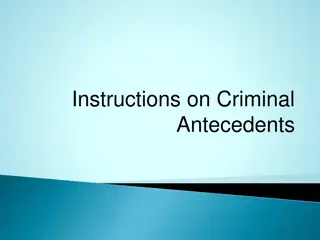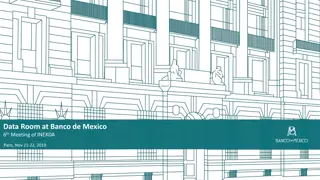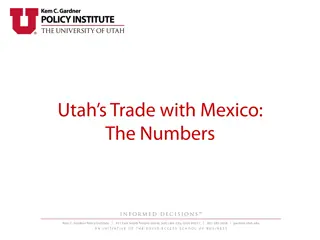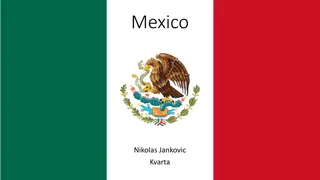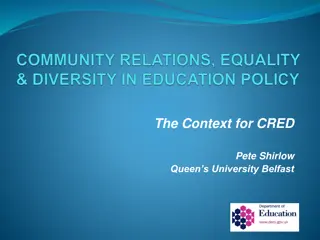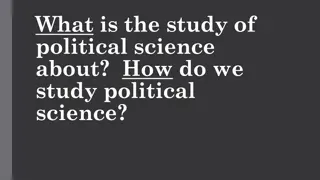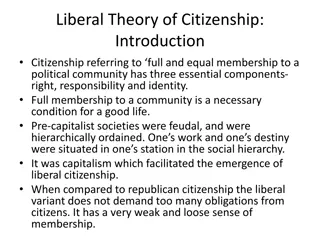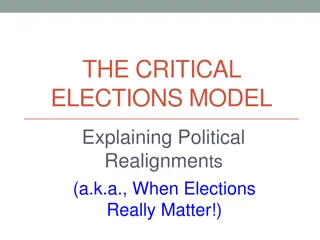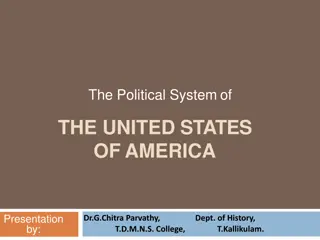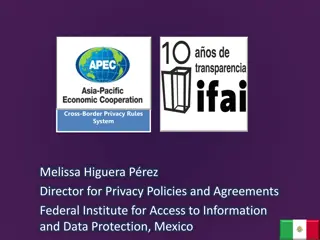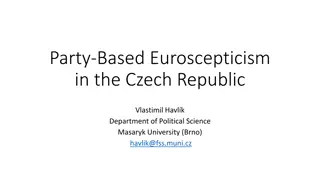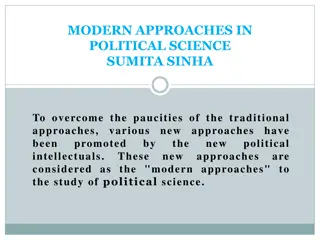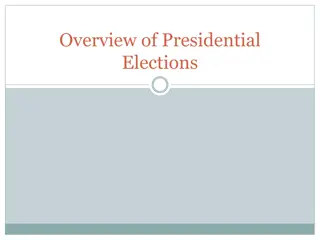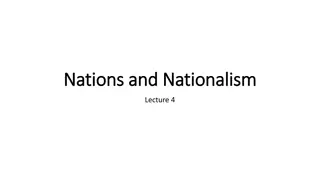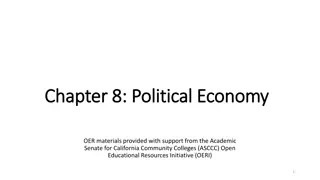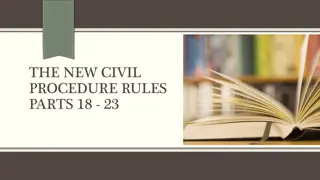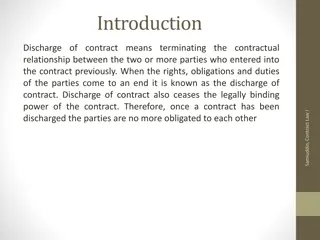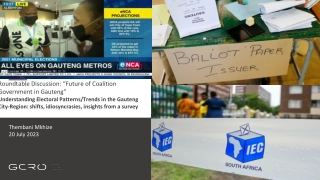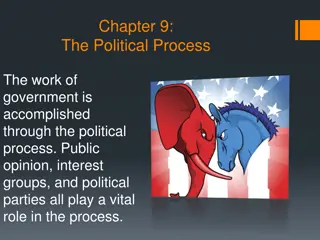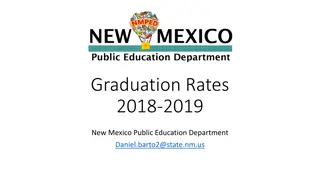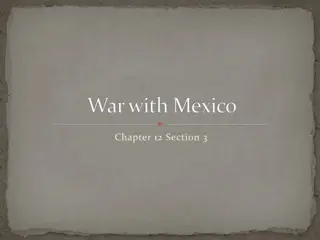Evolution of Political Parties in Mexico: A Historical Overview
Mexico's political system transitioned from a hegemonic party structure to a pluralist system with increased electoral competition. The role of political parties, constitution reforms, and the evolution towards democratic participation are highlighted, reflecting the country's political development over the years.
Download Presentation

Please find below an Image/Link to download the presentation.
The content on the website is provided AS IS for your information and personal use only. It may not be sold, licensed, or shared on other websites without obtaining consent from the author. Download presentation by click this link. If you encounter any issues during the download, it is possible that the publisher has removed the file from their server.
E N D
Presentation Transcript
Political Parties Regime Mexico s Experience Mtro. Patricio Ballados Villag mez Executive Director of Prerogatives and Political Parties of the National Electoral Institute February 2015 1
Content Background Registration Financing Media Access Loss of Registration 2 2
Background Mexican Political System Mexico is formed by a federation of 31 free and sovereign states plus a Federal District. We are a Federal Republic of Presidential Cut where the executive branch is ruled by the president of the republic which is chosen throughout universal and direct vote every six years without any possibility of reelection. The legislative branch resides in the Union Congress, a bicameral body consisting in the Chamber of Deputies, with 500 members and 128-member Senate. As for the political organization of the states the executive level plays the same outline of the presidency, with direct election of the governor every six years, while the legislative and municipal level, the election takes place every three years. 3
Background System of Parties PARTIES MUST FULLFILL CERTAIN REQUISITS They must be something different to the political factions. Parties emerged as a positive evolution of the political factions. They must elaborate and promote a political project that satisfies the aspirations of its members as from other individuals and sectors of society. In a political regime, they recognize the existence of other parties and accept that those also may organize and promote political projects even different of theirs. It is essential that the parties become a channel of communication between the governed and the governors. In this regard, parties are loyal to the political system when they electoral field, and only in it, the basic mechanisms to obtain power and exercise it. recognize in the 4
Background Parties Regime in Mexico M xico has gone from a hegemonic party system to a pluralist system of competitive parties. This is now a reflection of the political pluralism that exists in the country. The main characteristics of hegemonic party system were: a. Restricted access to political power. b. Lack of political-electoral competition. c. Distrust towards pluralism by society In the period of 1977 to 1996 there were several electoral reforms that built the chances of electoral competition in Mexico. Among other changes, we include the following: a. Introduction of proportional representation in Congress (1977). b. Elimination of governance clause and incorporation of limits to the political representation (1990). c. Creation of electoral authorities and the output of the government in the organization of elections (1996). 5
Background Constitution and Political Parties Reform of December 6, 1977. Articule 41 Fixed the new foundations that ruled the Mexican Electoral Law Allowed the gradual development of a system of Political Parties LEGAL NATURE: Public interest entities. [Associations of private character, ruled by Public Law. PURPOSES: 1)Promote people s participation in democrratic life; 2) Contribute to integrate national representation; 3) Enable the access of citizens to public power, according to the programs, principles and ideas that postulate, through universal, free, secret and direct suffrage. RIGHTS: Permanent use of social media and material elements for the promotion and attainment of suffrage. 6
Backgraound National Electoral Institute in the Parties Regime Corresponds to the Institute:* a. The registration of national political parties and the logbook of local political parties; b. The recognition of rights and access to prerogatives of the national political parties and candidates to federal elective positions; c. The organization of the election of political party leaders, at their request, from its prerogatives, in the terms established by Law; d. The audit of income and expenses of political parties, their coalitions, national political groups and candidates to local or federal positions. e. Others established in the Constitution and Law. * Article 7 of the General Law on Political Parties[LGPP] 7
Registration Requirements * Present a statement of principles and in consistent with these, a program of action and the statutes that will rule their activities; Have 3 000 militants in at least 20 states or Have 300 militants, in at least 200 electoral districts, and Under no circunstances, shall the total number of its militants in the country may be less than 0.26 percent of the federalelectoral roll. [For this last registration process, the minimum number was 219,608 affiliates] Application ** The organization of citizens attempting to form a political party to obtain its registration with the Institute, shall report that intention in the month of January following the election of President of the United Mexican States , (Every 6 years) * Article 10, number 2 of theLGPP ** Article 11, number 1 de la LGPP 8
Political Parties in Mexico NO. LOGO NAME Partido Acci n Nacional (PAN) 1 Partido Revolucionario Institucional (PRI) 2 Partido de la Revoluci n Democr tica (PRD) 3 Partido del Trabajo (PT) 4 Partido Verde Ecologista de M xico (PVEM) 5 Movimiento Ciudadano 6 Nueva Alianza 7 Morena 8 Partido Humanista 9 Encuentro Social 10 9
Financing Kinds Private: Coming from activists, supporters, contributions, loans, credits, events, etc. Public: Overall 30% is shared equally and 70% according to the electoral preferences. A. Direct 1) To support their permanent ordinary activities. [It is set annually] 2) For activities to obtain votes. [In election year] 3) Specific activities relating to education, training, socio-economic research and policy. [Annually] B. Indirect: Services for which the Parties don t pay: Loan places, spaces to disseminate ideology, postal and telegraphic franchise, as well as access to Radio and TV. As a result of the disparity between the powerful and weak parties, the General Constitution provides that public resources should prevail over those of private origin. 10
Public Financing Calculation 1) Ordinary Activities: Multiplying the total number of registered voters on the electoral roll by 65% of the minimum daily wage in the Federal District. $3,909,545,803.15 In 2015: 85,801,510 citizens X $45.57 pesos = 2) Campaign Activities: a. When President of the Republic is elected, it s equal to 50% of funding form ordinary activities; b. When only federal deputies are elected, its equal to 30% of that funding. In 2015 : The 30% equals the amount of [Year of the election of federal diputies] $1,172,863,740.95 3) Specific activities: 3% of the total annual amount of funding from ordinary activities. In 2015: $117,286,374.09 11
Media Access (Radio and Tv) Electoral Reform 2007-2008 Proposed: A more proactive and less dependent electoral race on the media. Established: A line of civility for the content of messages of political parties and their candidates. Regulated: The administration of the times of state in Radio and TV and promoted electoral campaigns based on proposals and rapprochement with the citizens. Modified: The Political Parties can t buy time on radio or TV, nor any third party can do it for them. Times The INE has 48 daily minutes from primaries until the day of the election at each station of Radio and every TV channel. The media time is distributed as follows: 30% equally and 70% according to the electoral preferences. During campaigns, the INE may organize debates as stated by the General Council and the proposals of the parties. 12
Loss of Registration Assumptions* Do not participate in a regular electoral process Do not get at least 3% of valid votes cast in any election Having failed to comply with the requirements for registration. Failure serious and systematic in the obligations marked in the electoral regulations; Have been declared dissolved by resolution of its members and Have merged with another political party. Effects** Lose of all rights and privileges established under the electoral law and, The extinction of the legal personality of the political party, but those who were their leaders and candidates must fulfill the obligations in the supervision established by the law, until the conclusion of the respective procedures and liquidation of its assets. * Article 94 of the LGPP ** Article 96 of the LGPP 13
Loss of Registration Minimum % Historic From 1991 to 1996 for not reaching 1.5% of the voting, lost their registration: 7 political parties From 1996 to 2013 for not reaching 2% of the national voting, lost their registration: 12 political parties The current minimum percentage required by the Constitution is 3%. o It does not constitute a limitation to multiparty system, and avoid an excessive fragmentation of it. It is considered that a reasonable number of parties allows citizens to clearly distinguish the actions and strategies of its political action. o Moreover, a higher threshold, forces political parties to work to become a serious alternative of representation among the electorate. 14


